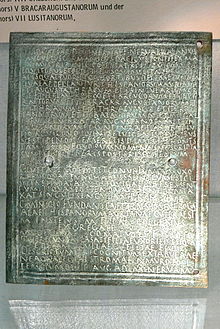Cohors III Britannorum
The Cohors III Britannorum [Antoniniana] [equitata] ( German 3rd cohort of Britannians [the Antoninian] [partly mounted] ) was a Roman auxiliary unit . It is evidenced by military diplomas , inscriptions and brick stamps.
Name components
- Britannorum : the Britannian. The soldiers of the cohort were recruited on the territory of the Roman province of Britannia when the unit was established . The auxiliary units set up in Britain have three different names: Britannica , Britannorum and Brittonum . The reasons why different names were chosen are unclear.
- Antoniniana : the Antoninian. An honorary title that refers to Caracalla (211-217). The addition comes in the inscription ( CIL 03, 14111 before).
- equitata : partially mounted. The unit was a mixed association of infantry and cavalry. The addition appears in the inscription ( CIL 03, 14111 ).
Since there is no evidence of the addition of milliaria (1000 men) to the name , the unit was a Cohors (quingenaria) equitata . The nominal strength of the cohort was 600 men (480 infantry and 120 horsemen), consisting of 6 centuries of infantry with 80 men each and 4 tower cavalry with 30 horsemen each.
history
The cohort was probably moved from the province of Britannia to the province of Raetia before AD 69 . The unit then possibly took part in the suppression of the Helvetian uprising by Aulus Caecina Alienus and subsequently moved with Caecina to northern Italy. After Vespasian had prevailed as the winner in the year of the Four Emperors , the cohort was moved back to Raetia.
The first evidence of unity in Raetia is based on a military diploma dated to the year 86. In the diploma, the cohort is listed as part of the troops (see Roman Armed Forces in Raetia ) that were stationed in the province. Other diplomas, dated 107 to 166, prove unity in the same province.
The unit is mentioned for the last time in the Notitia dignitatum with the designation Cohors tertia Brittorum for the Abusina site. It was part of the troops under the command of the Dux Raetiae , under the direction of a tribune .
Locations
Cohort locations in Raetia may have been:
- Burgsalach : The unit could have been stationed between 120 and 160 in the large wood-earth warehouse.
- Eining (Abusina): inscriptions and brick stamps attest to the presence of the unit in Abusina. It is also listed in the Notitia dignitatum for this location.
- Kumpfmühl : The fort was possibly built by the unit around 69/70.
Members of the cohort
The following members of the cohort are known:
Commanders
|
|
Others
|
|
See also
Web links
Remarks
- ↑ The inscription was found at Esztergom Castle . John Spaul assigns the inscription of Cohors III Brittonum to, Farkas István Gergő however, the Cohors III Britannorum .
- ↑ a b c d e f The inscription was found at Eining Fort , where the Cohors III Britannorum , the Cohors IV Gallorum and a vexillation of the Cohors II Tungrorum were stationed. An exact assignment of the listed soldier to one of these units is not possible because the name of the unit is missing in the inscription.
- ↑ a b c d e The inscription was found near Regensburg, where, according to Farkas István Gergő, the Cohors II Aquitanorum , the Cohors III Britannorum and the Legio III Italica were stationed. An exact assignment of the listed soldier to one of these units is not possible because the name of the unit is missing in the inscription.
- ↑ a b The inscription was found near Neustadt an der Donau , where, according to Farkas István Gergő, the Ala I Flavia Singularium and the Cohors III Britannorum were stationed. An exact assignment of the listed soldier to one of these units is not possible because the name of the unit is missing in the inscription.
Individual evidence
- ^ A b c John Spaul: Cohors² The evidence for and a short history of the auxiliary infantry units of the Imperial Roman Army , British Archaeological Reports 2000, BAR International Series (Book 841), ISBN 978-1-84171-046-4 , Pp. 189, 202.
- ↑ a b c Tatiana Alexandrovna Ivleva: Britons abroad: the mobility of Britons and the circulation of British-made objects in the Roman Empire Dissertation, Leiden University 2012, pp. 120-127, 525-534 ( online ).
- ↑ a b c d e Farkas István Gergő: The Roman Army in Raetia Dissertation, University of Pécs Faculty of Humanities 2015, pp. 149–150, 244–259, 404–408, 468, 481–482 ( PDF 19.1 MB , Pp. 152–153, 247–262, 407–411, 471, 484–485 ( memento of the original dated December 14, 2016 in the Internet Archive ) Info: The archive link was automatically inserted and not yet checked. Please check the original and Archive link according to instructions and then remove this note. ).
- ^ Jörg Scheuerbrandt : Exercitus. Tasks, organization and command structure of Roman armies during the imperial era. Dissertation, Albert-Ludwigs-Universität Freiburg im Breisgau 2003/2004, p. 160 table 4 ( PDF p. 162 ).
- ↑ Military diplomas of the years 86 ( AE 2007, 1782 ), 107 ( CIL 16, 55 ), 116 ( AE 1995, 1185 , RMD 3, 155 ), 128/133 ( AE 2005, 1150 ), 138/140 ( RMD 2, 94 ), 139 ( RMD 4, 261 , RMD 5, 386 ), 140 ( RMD 5, 387 ), 154/161 ( CIL 16, 117 , RMD 3, 175 ), 156 ( CIL 16, 183 ), 156/157 ( RMD 1, 51 ), 157 ( RMD 3, 170 , RMM 38 ), 159/160 ( AE 2005, 1153 ), 160 ( RMD 4, 278 ), 161/163 ( RMD 2, 112 ), 161/168 ( CIL 16, 125 ) and 166 ( CIL 16, 121 ).
- ^ Notitia dignitatum in partibus Occidentis XXXV ( online ).

